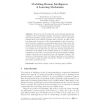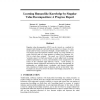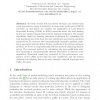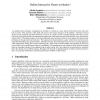499 search results - page 52 / 100 » Learning Through Telemedicine Networks |
MICAI
2005
Springer
14 years 1 months ago
2005
Springer
We propose a novel, high-level model of human learning and cognition, based on association forming. The model configures any input data stream featuring a high incidence of repeti...
NIPS
1997
13 years 9 months ago
1997
Singular value decomposition (SVD) can be viewed as a method for unsupervised training of a network that associates two classes of events reciprocally by linear connections throug...
NETCOOP
2007
Springer
14 years 1 months ago
2007
Springer
Recently Gerald Ash has shown through case studies that event dependent routing is attractive in large scale multi-service MPLS networks. In this paper, we consider the application...
NPL
2000
13 years 7 months ago
2000
In standard neuro-evolution, a population of networks is evolved in a task, and the network that best solves the task is found. This network is then fixed and used to solve future...
ECTEL
2006
Springer
13 years 11 months ago
2006
Springer
Bayesian networks are commonly used in cognitive student modeling and assessment. They typically represent the item-concepts relationships, where items are observable responses to ...




